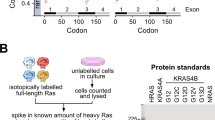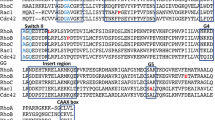Abstract
Rac1 is a member of the Ras superfamily of small guanosine triphosphatases (GTPases) that act as molecular switches to control cytoskeletal rearrangements and cell growth. Analogous to Ras, constitutively activating point mutations of Rac1 cause tumorigenic transformation of cell lines. However, there is no information about whether Rac1 is also mutated in vivo. After RT–PCR of Rac1, several clones of seven benign and 10 malignant breast cancer tissues as well as eight breast cancer cell lines were sequenced. Only single-nucleotide polymorphisms of Rac1 could be detected, and none of these corresponded to constitutively activating point mutations that have been used in cell lines for transformation. While sequencing Rac1 in breast tissues, a new Rac1 isoform with an insertion of 19 codons within the reading frame of Rac1 close to switch region II was identified and named Rac1b. The Rac1b protein acts like a fast cycling GTPase in GTP binding and hydrolysis assays. In Northern and Western blot experiments both Rac1 RNA and Rac1 protein had a significantly higher expression in breast cancer tissues compared to normal breast tissue samples. Immunohistochemical staining of Rac1 showed weak Rac1 expression in benign breast disease but high expression level in ductal carcinoma-in-situ, primary breast cancer, and lymph node metastases. In addition, breast tumor cells from patients with recurrent disease had Rac1 expression at the plasma membrane, suggesting activation of Rac1, in patients with aggressive breast cancer.
This is a preview of subscription content, access via your institution
Access options
Subscribe to this journal
Receive 50 print issues and online access
$259.00 per year
only $5.18 per issue
Buy this article
- Purchase on Springer Link
- Instant access to full article PDF
Prices may be subject to local taxes which are calculated during checkout




Similar content being viewed by others
References
Anand-Apte B, Zetter BR, Viswanathan A, Qiu RG, Chen J, Ruggieri R and Symons M . 1997 J Biol Chem 272: 30688–30692
Bacher A, Griebl K, Mackamul S, Mitreiter R, Muckter H and Ben-Shaul Y . 1992 Exp Cell Res 200: 97–104
Baudet AL and Tsui L-C . 1993 Hum Mutat 2: 245–248
Bos JL . 1989 Cancer Res 49: 4682–4689
Burstein ES, Hesterberg D, Gutkind S, Brann MR, Currier EA and Messier TL . 1998 Oncogene 17: 1617–1623
Chuang TH, Xuemin X, Quilliam LA and Bokoch GM . 1994 Biochem J 303: 761–767
Coso O, Chiariello M, Yu JC, Teramoto H, Crespo P, Xu N, Miki T and Gutkind S . 1995 Cell 81: 1137–1146
Dickson RB, Salomon DS and Lippmann ME . 1992 Cancer Treat Res 61: 249–273
Didsbury J, Weber R, Bokoch GM, Evans T and Snyderman R . 1989 J Biol Chem 264: 16378–16382
Fleming IN, Elliott CM and Exton JH . 1996 J Biol Chem 271: 33067–33073
Hall A . 1998 Science 279: 509–513
Harbeck N, Thomssen C, Berger U, Ulm K, Kates R, Höfler H, Jänicke F, Graeff H and Schmitt M . 1999 Breast Cancer Res Treat 54: 147–157
Hunter T . 1997 Cell 88: 333–346
Jordan P, Brazao R, Boavida MG, Gespach C and Chastre E . 1999 Oncogene 18: 6835–6839
Keely JP, Westwick JK, Whitehead IP, Der CJ and Parise LV . 1997 Nature 390: 632–636
Khosravi-Far R, Solski PA, Clark JG, Kinch MS and Der CJ . 1995 Mol Cell Biol 15: 6443–6453
Knaus U, Heyworth P, Kinsella B, Curnutte JT and Bokoch GM . 1992 J Biol Chem 267: 23575–23582
Krizman D, Chuaqui RF, Meltzer PS, Trent JM, Duray PH, Linehan WM, Liotta L and Emmert-Buck MR . 1996 Cancer Res 56: 5380–5383
Lengyel E, Wang H, Stepp E, Juarez J, Wang Y, Doe WF, Pfarr CM and Boyd D . 1996 J Biol Chem 271: 23176–23184
Lin R, Bagrodia S, Cerione R and Manor D . 1997 Curr Biol 7: 794–797
Olson MF, Ashworth A and Hall A . 1995 Science 269: 1270–1272
Parada L, Tabin C, Shih C and Weinberg RA . 1982 Nature 297: 474–478
Qiu R-G, Chen J, Kirn D, McCormick F and Symons M . 1995 Nature 374: 457–459
Quinn MT, Evans T, Loetterle LR, Jesaitis AJ and Bokoch GM . 1993 J Biol Chem 268: 20983–20987
Schaller G, Fuchs I, Pritze W, Ebert A, Kratsch HC, Herbst H, Pantel K and Lengyel E . 1996 Clin Cancer Res 2: 1879–1885
Schürmann A, Brauers A, Maßmann S, Becker W and Joost H-G . 1995 J Biol Chem 270: 28982–28988
Self A and Hall A . 1995 Methods Enzymology 256: 3–11
Sivaraman VS, Wang H-Y, Nuovo GJ and Malbon CC . 1997 J Clin Invest 99: 1478–1483
Thompson EW, Paik S, Brunner N, Sommers CL, Zugmaier G, Clarke R, Shima TB, Toth M, Lippman ME and Dickson RB . 1992 J Cell Physiol 150: 534–544
Xu X, Wang Y, Barry DC, Chanock SJ and Bokoch GM . 1997 Biochemistry 36: 626–632
Zohn I, Campbell SL, Khosravi-Far R, Rossman KL and Der CJ . 1998 Oncogene 17: 1415–1438
Acknowledgements
We thank Dr A Zollner, Max-Planck Institut für Biochemie, Martinsried, Germany, for help with database analysis, Dr L Sanders, the Scripps Research Institute, Dept. of Immunology, La Jolla, CA for valuable suggestions and R Manson for critical reading of the manuscript. The authors also acknowledge the assistance of K Gauger. This research was supported by grants from the Technische Universität München (KKF 8756156 to E Lengyel and M Schmitt and KKF 8756159 to N Harbeck), the Wilhelm Sander-Stiftung (96.041.1 to E Lengyel and M Schmitt), and by funds provided by the Breast Cancer Fund of the State of California through the Breast Cancer Research Program of the University of California (2RB-0229 to U Knaus). A Schnelzer performed this study in partial fulfilment of his MD thesis and was supported by a short-term fellowship from the Boehringer Ingelheim Fonds.
Author information
Authors and Affiliations
Rights and permissions
About this article
Cite this article
Schnelzer, A., Prechtel, D., Knaus, U. et al. Rac1 in human breast cancer: overexpression, mutation analysis, and characterization of a new isoform, Rac1b. Oncogene 19, 3013–3020 (2000). https://doi.org/10.1038/sj.onc.1203621
Received:
Revised:
Accepted:
Published:
Issue Date:
DOI: https://doi.org/10.1038/sj.onc.1203621
Keywords
This article is cited by
-
RAC1B function is essential for breast cancer stem cell maintenance and chemoresistance of breast tumor cells
Oncogene (2023)
-
Rac1 activation in oral squamous cell carcinoma as a predictive factor associated with lymph node metastasis
International Journal of Clinical Oncology (2023)
-
Novel rapid immunohistochemistry using an alternating current electric field identifies Rac and Cdc42 activation in human colon cancer FFPE tissues
Scientific Reports (2022)
-
Förster resonance energy transfer biosensors for fluorescence and time-gated luminescence analysis of rac1 activity
Scientific Reports (2022)
-
The role of insulin and incretin-based drugs in biliary tract cancer: epidemiological and experimental evidence
Discover Oncology (2022)



